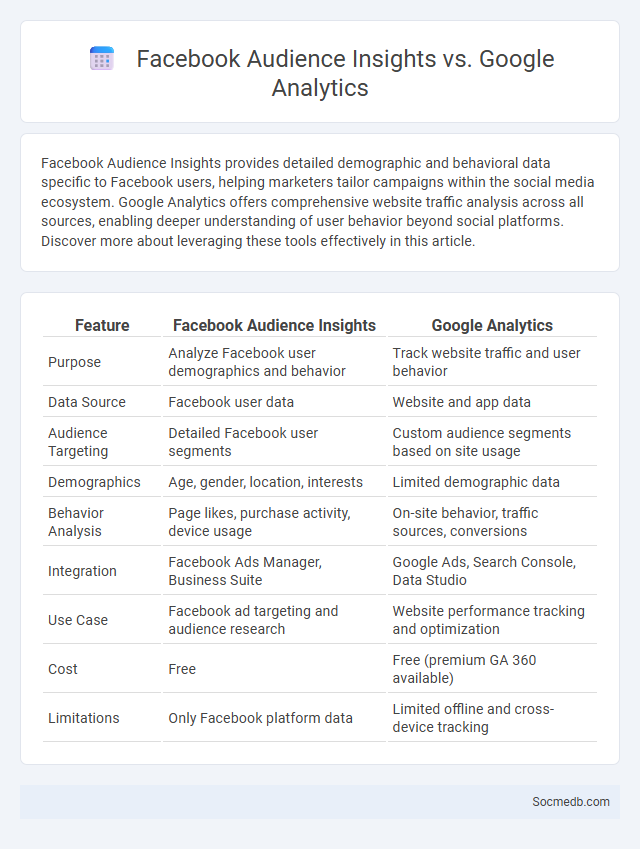
Photo illustration: Facebook Audience Insights vs Google Analytics
Facebook Audience Insights provides detailed demographic and behavioral data specific to Facebook users, helping marketers tailor campaigns within the social media ecosystem. Google Analytics offers comprehensive website traffic analysis across all sources, enabling deeper understanding of user behavior beyond social platforms. Discover more about leveraging these tools effectively in this article.
Table of Comparison
| Feature | Facebook Audience Insights | Google Analytics |
|---|---|---|
| Purpose | Analyze Facebook user demographics and behavior | Track website traffic and user behavior |
| Data Source | Facebook user data | Website and app data |
| Audience Targeting | Detailed Facebook user segments | Custom audience segments based on site usage |
| Demographics | Age, gender, location, interests | Limited demographic data |
| Behavior Analysis | Page likes, purchase activity, device usage | On-site behavior, traffic sources, conversions |
| Integration | Facebook Ads Manager, Business Suite | Google Ads, Search Console, Data Studio |
| Use Case | Facebook ad targeting and audience research | Website performance tracking and optimization |
| Cost | Free | Free (premium GA 360 available) |
| Limitations | Only Facebook platform data | Limited offline and cross-device tracking |
Introduction to Audience Analysis Tools
Audience analysis tools provide detailed insights into your social media followers' demographics, interests, and behaviors, allowing for precise content targeting. Platforms like Facebook Insights, Twitter Analytics, and Instagram Audience Insights offer data on age, gender, location, and engagement patterns to optimize your marketing strategy. Leveraging these tools helps you tailor campaigns effectively and increase audience interaction.
Understanding Facebook Audience Insights
Facebook Audience Insights provides detailed data on user demographics, interests, and behaviors, helping you tailor your content effectively. Accessing insights about age, gender, location, and page likes allows you to identify and engage your ideal audience more precisely. Leveraging this information optimizes your social media strategy and enhances campaign targeting on Facebook.
Exploring Google Analytics for Audience Data
Exploring Google Analytics for audience data helps you gain valuable insights into user demographics, interests, and behavior on social media platforms. By analyzing metrics such as age, gender, location, and device type, you can optimize your content strategy to target the right audience more effectively. This data-driven approach enhances your social media marketing efforts, leading to increased engagement and better ROI.
Defining Your Target Audience
Defining your target audience on social media sharpens your content strategy and increases engagement by focusing on users most likely to connect with your brand. Analyze demographics, interests, behavior patterns, and platform preferences to create tailored messages that resonate on a deeper level. Understanding your audience's pain points and aspirations ensures your campaigns deliver value and drive meaningful interactions.
Key Features Comparison: Facebook vs Google Analytics
Facebook offers robust audience targeting and engagement metrics centered on social interactions, providing insights into user demographics, post performance, and ad reach within its platform. Google Analytics excels in tracking website traffic patterns, user behavior flows, conversion rates, and multi-channel attribution across diverse digital properties. The key difference lies in Facebook's social-centric data versus Google Analytics' comprehensive web performance and user journey analysis.
Data Sources and Accuracy: A Deep Dive
Social media platforms generate massive volumes of data from diverse sources such as user-generated content, interactions, and metadata, enabling granular insights into user behavior and trends. Ensuring data accuracy involves sophisticated techniques like natural language processing, sentiment analysis, and cross-referencing with verified datasets to filter noise and reduce bias. Leveraging reliable data sources and applying rigorous validation methods enhances the credibility of social media analytics for marketing, research, and decision-making processes.
Segmentation Capabilities of Each Platform
Facebook excels in demographic and interest-based segmentation, allowing advertisers to target users by age, location, interests, and behaviors. Instagram leverages visual content preferences and influencer followings to create niche audience segments centered on lifestyle and trends. LinkedIn offers robust professional segmentation, enabling precise targeting based on job title, industry, skills, and company size, ideal for B2B marketing campaigns.
Real-Time Insights and Reporting
Real-time insights and reporting on social media platforms enable businesses to track audience behavior, engagement metrics, and campaign performance instantaneously. Advanced analytics tools process data streams from multiple channels like Facebook, Twitter, and Instagram, providing actionable metrics such as reach, impressions, and click-through rates. Immediate feedback allows marketers to optimize content strategies, enhance targeting, and maximize ROI effectively.
Choosing the Right Tool for Your Audience Strategy
Selecting the appropriate social media platform is crucial for maximizing audience engagement and aligning with your brand's goals. Analyze demographic data and user behavior on platforms such as Instagram, TikTok, LinkedIn, and Facebook to match your content style with the preferences of your target audience. Leveraging analytics tools like Google Analytics and native social media insights ensures continuous optimization and effective audience targeting for your strategy.
Conclusion: Maximizing Audience Understanding
Maximizing audience understanding on social media requires leveraging data analytics tools to analyze user behavior, engagement patterns, and content preferences. Tailoring your posts with targeted keywords and clear messaging increases relevance, ensuring your content resonates with your specific demographic. You can enhance reach and impact by consistently monitoring performance metrics and adapting strategies based on audience insights.
 socmedb.com
socmedb.com